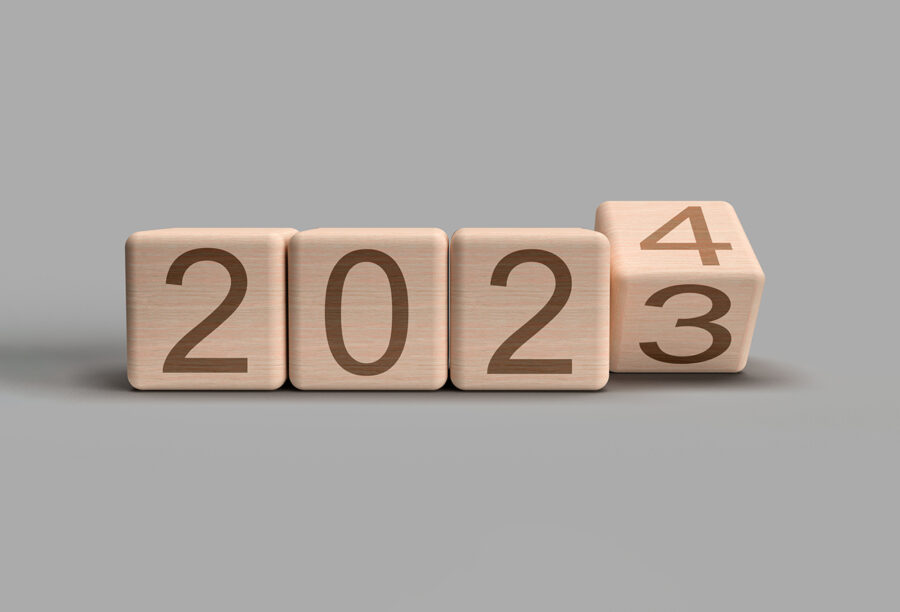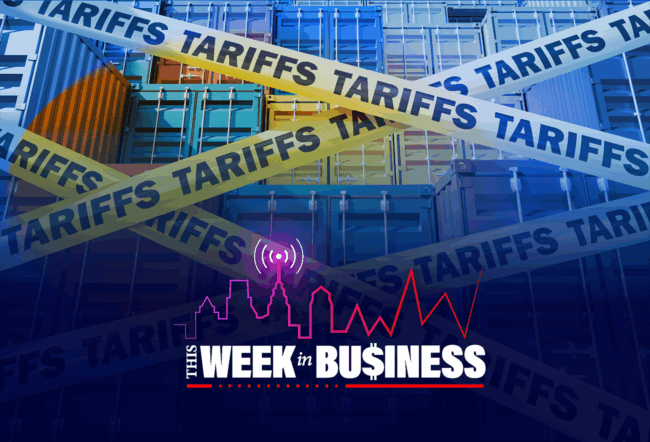The U.S. economy heads into 2024 with expectations that the Federal Reserve will lower interest rates as inflation appears tamed. “The Fed has to realize that all its tightness is in the pipeline and will continue to press on the economy in 2024. They must start thinking about lowering rates,” Wharton emeritus professor of finance Jeremy Siegel said on the Wharton Business Daily radio show that airs on SiriusXM. (Listen to the podcast above.)
“Inflation is beat,” Siegel said. “My big hope is that the Fed doesn’t get stuck on the downside and delay the way it did on the upside, tightening way too late.” 2023 saw the economy more resilient than many experts had predicted — productivity surged, and so did the stock market. “[But] we do have a slowing economy now, so we do have to watch out for 2024,” Siegel warned. If a recession occurs, it won’t be severe, he said. The stock market seems poised for continued strength, he added. “We could definitely get [the Dow] past 40,000.”
Read an edited transcript from the conversation below.
Transcript
Wharton Business Daily: Please give us a recap of what happened regarding the expectations you had a year ago, of what we might see play out in 2023.
Jeremy Siegel: I was right on some things, not on others. I was right that the economy would rebound. I thought productivity would come back, which it did. I was also right on the stock market. That was way out of line with the consensus, which was, for the first time in 20 years, actually predicting a negative outlook for stocks. I was wrong on interest rates; I thought the Fed would start lowering rates by the middle of 2023, and it certainly didn’t. It kept on raising them. But I predict there will be no more hikes, and rates will come down.
I was right on the rebound of the economy, but what I didn’t appreciate was how much internal strength this economy had. And everyone was surprised — the Fed, and the private forecasters. They all thought that if interest rates would stay this high, we would be in a much slower economy than we had. However, we do have a slowing economy now, so we do have to watch out for 2024.
Conditions Ripe for Lowering Rates?
Wharton Business Daily: The expectation is that after we had 5.2% GDP growth in Q3, we were going to see a slowdown, but to what level is still to be determined. Is your expectation that we’ll probably see that carry over at least through the first quarter of next year?
Siegel: Absolutely. Current GDP growth expectations for the fourth quarter are between 1% and 2%, Of course, the quarter depends on Christmas sales. December is important [to see] whether sentiment holds up.
Inflation is beat There will be core elements in the CPI that will continue to rise, and institutionally determined prices that take months to come down. But to eliminate those remaining price increases would mean crushing the economy, and that would be unadvisable from an economic standpoint.
Strong Consumer Spending the Biggest Driver
Wharton Business Daily: Are your expectations in terms of the stubbornness of the economy more around the labor market? Is it around consumer spending? Which were the areas that maybe caught you off guard?
Siegel: [It is] solely consumer spending. That was much stronger than anticipated. There was still a lot of pandemic money that was spent, and it’s in the last stages of being absorbed right now. Also, the higher interest rates are not having as devastating an effect that many of us thought. Housing has slowed but is not collapsing, although recently the Home Builders’ sentiment index has gone back down again. People still view homes as great long-term hedges against inflation. Builders are buying down mortgages to 5% and 6%, and homeowners are continuing to put their money in real estate
If you have your home, you have a lot of excess equity. Home prices have gone up 50% in the last three years, so there is a lot of home equity that has built up, supporting consumer spending. For corporations, debt is more costly than it was, but that debt is a promise to pay dollars. If we’re going to have [higher] inflation in the future, those dollars will be worth less.
Labor Market Trends Signal a Recession
Wharton Business Daily: Are you expecting to see, then, some sort of labor contraction ahead? We’ve seen companies anecdotally over the course of the year announce job cuts. It hasn’t seemed to be the wide swath that maybe some people had believed that it would be, but it seems like that is still a possibility.
Siegel: Yes, absolutely. There is definitely a slowdown. And the real data is almost consistently on the weak side, weaker than expectations over the last six weeks.
You’re beginning to hear anecdotal statements about the job market that are more negative than I’ve heard since the pandemic. Even in the erstwhile hot areas such as biotech, people are saying it isn’t as hot as it used to be. So, we have to be on the lookout there.
We also have to realize that the unemployment rate has gone up from 3.4% [in April 2023] to 3.9% in October 2023, [although it fell to 3.7% in November]. It still could reach 4%. That’s generally a trigger for a recession watch – once it goes up by one-half percent. So, we are near a recession watch. I don’t expect a recession, but if we have it, it won’t be severe. Certainly, we do not have the robustness that we’ve had in the past two years
Wharton Business Daily: But it still seems like there is still a strength in the labor force in general. Layoffs have not been as widespread as many people expected.
Siegel: Absolutely, and I thought we would begin to see much more labor softness in 2023, although I wasn’t as pessimistic as a few economists like Larry Summers who predicted a deep recession by the second half of 2023. But even the Fed over-predicted unemployment
At the same time, although inflation has gone down quite a lot It hasn’t been vanquished a hundred percent. It’s a long process. My big hope is that the Fed doesn’t get stuck on the downside and delay the way it did on the upside, tightening way too late in 2021 and 2022. The Fed must be preemptive. They must start thinking about lowering [the interest rate]. Even if they don’t lower it in January, they may have to lower it in the March 2024 meeting. [The Fed in its December 13 meeting held the benchmark overnight borrowing rate unchanged in a targeted range between 5.25% and 5.5%. It also indicated three rate cuts in 2024.)
Room to Lower Rates
Wharton Business Daily: Is your expectation that each time the Fed cuts interest rates, it will probably be incremental, like a quarter percentage point?
Siegel: Yes, I think so, unless the data falls off the cliff, which I don’t expect. However, if inflation strengthens, the Fed still has the option of [interest rates] going up, but I don’t expect that to happen. [At a press conference after the December 2023 meeting, Powell gave clear indications that the Fed sees room for easing interest rates.]
Wharton Business Daily: This is a unique time in terms of economic history, making adjustments for a soft landing after what we went through in the pandemic.
Siegel: Yes, it is really difficult. We really hadn’t had a pandemic economy [earlier]. A hundred years ago, during the Spanish flu, the economy didn’t shut down, so we’ve really never experienced what happened before during a pandemic in modern times. So, that automatically means that there could be unusual events, not consistent with the past, that are happening.
I hear a lot of people praising the Fed and Powell. Before praising him so fulsomely, one should realize that he was the one who let it go too late, even causing the inflation. We didn’t have to have as much inflation as we had. Had the Fed started raising rates in early 2021 instead of early 2022, we would have had much less inflation.
Wharton Business Daily: What is your expectation with the Fed over the course of the year? How many times do you think they will cut the interest rate?
Siegel: Normally, the term structure dictates that we have higher long-term rates than short-term rates. Right now, the Fed Funds rate is between 5.25% and 5.5%, while the long-term bond is fully a point or more below that. That’s called an “inverted term structure.” It is unusual. It has, over the last 60 years, predicted a recession with a very high probability. We don’t want to keep that curve inverted.
The Fed must bring short rates down. I would prefer to bring it down 50 basis points below the long rate, which, if it stays at the current level, would mean bringing the Fed funds rate to 3.75% over the course of this year. We should see the Fed funds rate around 3%, if the long bond stays nearer to 4%.
The Dow at 40,000?
Wharton Business Daily: Is it time to even start to consider Dow 40K at this point? (The Dow Jones Industrial Average added 4,500 points in 2023 to close the year at 37,689.)
Siegel: Yes. Let’s put it this way: If the Fed responds quickly to a decline with a drop in interest rates, we could get another 15% rise in stocks from current level, with the small and midcaps participating more and fully because of the fear of recession being obviated.
We must get our money supply growing again. We must get the reserves of the banking system rising again. They’ve been stagnating. The money supply has gone nowhere in the past two- years. You need money to grow at about 5% a year to yield 2% or 2.5% real growth, and 2% to 2.5% inflation, which is the Fed’s target range.
If the Fed keeps money [supply] stagnant, as it has been, you are looking at a recession right in the face. That is why the Fed must ease.
The productivity rebound that we saw in 2023 can continue in 2024. We could have higher labor force participation, and the reshoring of many production processes would be another positive for the U.S. going forward. We could definitely get [the Dow] past 40,000. A 10% to 12% rise in stock prices is not out of the question for 2024. If the Fed is stubborn and says, “I’m just going against inflation, even if the data gets soft,” those figures would have to be adjusted downward.



